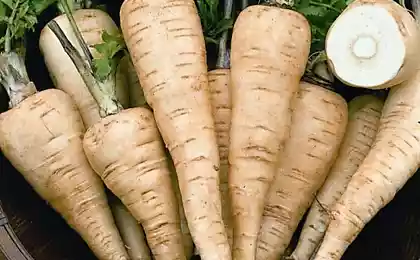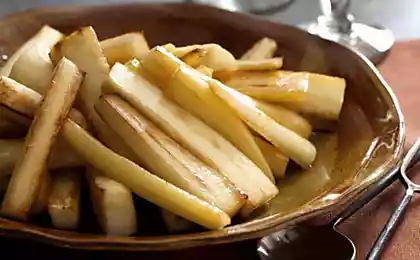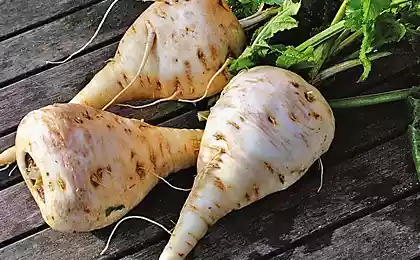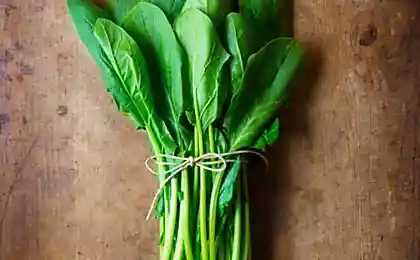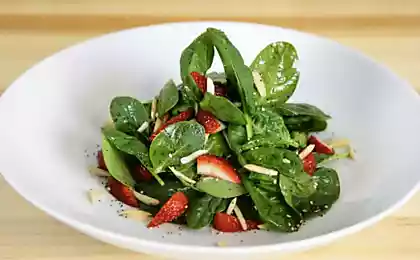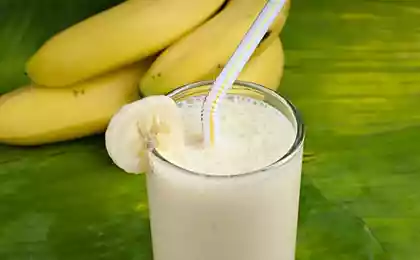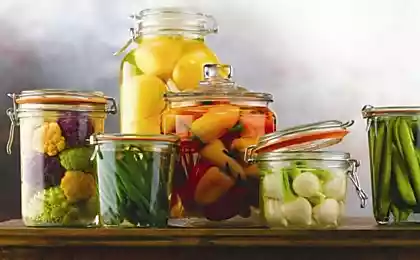760
Forgotten vegetables — spinach and parsnips: the amazing benefits + recipes
SPINACH — THE KING OF VEGETABLES
If there is in the world the plant, which was not lucky with the reputation, so is spinach. In the twenties and thirties of the last century appeared in print scientific articles in which it was reported that this fruit contains an incredible amount of chlorophyll and a lot of iron oxides, even called number — 3%.
Spinach was first announced a panacea, zeleste izanai anemia, and then adding the biological activity of chlorophyll, began to argue that he has a fantastic ability to increase hemoglobin in the blood. Echoes of this confusion can be found even now. In some articles still argues that the quantity and vitamin content of spinach is much superior to other green and spicy culture and that of protein is as much as in milk, and a lot of iron oxides and of course spinach can be "cured" of many illnesses.
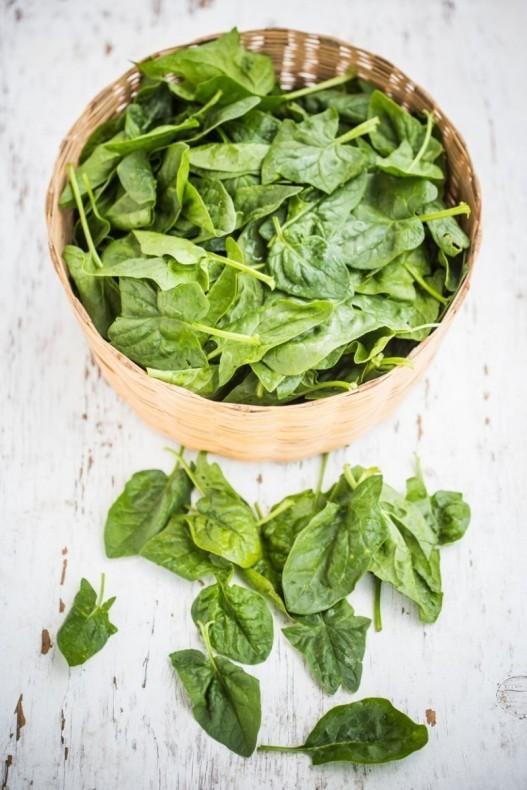
In fact, 3% of iron oxides found in the ash of the aerial parts of the plant, and this figure is overpriced, and the chlorophyll in the leaves a little more than in green leaves of any vegetable plants. Iron spinach contains about the same amount as potatoes, vitamins and other nutrients are present in virtually the same quantities as in other green crops. Spinach is undoubtedly useful, but it does not need to be credited with "miraculous" properties. It's a good green vegetable, but other only among equals.
It is believed that vegetable spinach (Spinacea oleracea L.) was cultivated long before BC in the middle East from widespread in those parts of the weed, a relative of well-known quinoa. In the VIII century, the spinach came to Spain with the Arab conquerors (the Arabs conferred on him the title "king of vegetables"), and then starting from the XV century thanks to the unpretentiousness to growing conditions, rapid growth and ease of cooking has spread to other European countries; it is especially partial to the Italians and French. But most of all were lucky the spinach in the USA, where he was with the first settlers and is still grown in huge quantities.
In Russia, the spinach as a vegetable crop began to be planted from the middle of XVIII century, but common, and even more a favorite vegetable, it did not become. Low popularity it owes its not very high taste, but the drawback is easy to fix, is to learn how to cook him meals.
Besides the usual for each plant proteins, fats, mono - and disaccharides, starch, fiber, organic acids spinach leaves contain flavonoids and a very good, balanced by nature multivitamin complex, which have provitamin a (carotenoids), b vitamins, C, P, PP, E, N. These vitamins in the spinach leaves accompanied by almost all necessary for the human macro - and microelements.
The variety of vitamins in combination with at least various minerals makes spinach a useful green vegetable for people of any age. It is used as a dietary product for diseases of the nervous system, exhaustion, anemia, anemia, hypertension, diabetes, gastritis, enterocolitis, he has a mild tonic, laxative, diuretic and anti-inflammatory action. Useful for recovering after a serious illness. And not only recommended for those who suffer from urinary, kidney, gallstone disease and gout.
One way or another, but to ignore this useful vegetable culture, all the more that to grow spinach is a snap.
How to grow spinach
To have a harvest throughout the summer and fall, you should sow the spinach seeds in open ground since the first of may. But since they do not germinate, they must first be soaked in a box with sawdust, place in open plastic bag and place in a warm place. After a week naklyunulis seeds can be sown at a depth of 2-3 cm and not a lot, otherwise the crop will be small. Between the grooves it is recommended to leave 25-30 cm In the phase of two true leaves the plants need to thin out, leaving between them at least 10 cm higher the yield will increase if you add pure humus and ash or lime, if the soil is acidic. Like spinach nitrophoska fertilizer and frequent watering, because the lack of moisture in the soil the seedlings appear late and disjointed, the leaves will be small, hard and plant quickly goes to flowering.
Crop harvested in 20-40 days after sowing, when plants have already formed a rosette of five or six leaves, and some will even see a small stem. Clean the spinach all at once, and since the leaves had a delicate and fade quickly, it's better to do early in the morning. The plant should pull out of the ground by the roots, shake, remove the yellow and damaged leaves and put roots down in a row. Fresh spinach leaves can be stored for five to seven days at a temperature of 1 ° C and relative humidity of 95%. They can and freeze. At a temperature of minus 1-2°C, the spinach stored for three months.
To obtain extra-early harvest next year's spinach seeds should be sown about the middle of August and well cover for the winter, not forgetting, if necessary, watered. By the end of the season, the plants formed small rosettes of leaves that are not taking cover, and leave for the winter. In early spring, immediately after snow melt, the spinach will "Wake up" and begin to grow rapidly. Literally 10-15 days after the snow it is already possible to gather the first harvest.
How to choose the right spinach at the store
Those of you who are infinitely far from the thought to grow anything, you can buy spinach fresh or frozen. When buying pay attention to the condition of the leaves. They should be bright green and look as if they just plucked from the garden. Fresh leaves are better to consume immediately or the next day, otherwise they will lose flavor and color. On sale all year round comes frozen spinach; when properly cooked it does not lose its taste and useful properties.
Spinach is used both in fresh and in processed form. It is added to salads, prepared from pasta, mashed potatoes, and various dishes as well as juice, which is used for coloring dishes.
Before cooking spinach thoroughly washed the leaves, a little dried and placed in a bowl with a small amount of water, lightly salt and put on low heat. Close lid and stew in their own juice for 5-7 minutes, watching so that the mixture doesn't stick to the bottom. The liquid is then drained, squeeze spoon her remains. Now the spinach is ready to use it in most recipes.
When cooking spinach it turned out dish, the taste and appearance of which suggest sad thoughts, do not rush to send it in the trash. Try to apply a universal tool, capable of making any dish of spinach simply delicious: add lemon seasoning consisting of 1 tablespoon of olive oil and 1 teaspoon squeezed lemon juice.
WHITE ROOT
Another once popular, now almost forgotten root vegetable with so unhappy destiny that when you say his name, some people think that we are talking about the names of the famous poet. But the fact that the roots of parsnip have been appreciated by Russian gourmets in the early twentieth century, very few people know. Spacerace in pre-revolutionary Russia was preparing easy vegetable dishes that were in the most exquisite menus for ceremonial feasts and receptions. In Europe during the Renaissance, this plant was as popular as it is today conventional potatoes. Now the growers on their acres parsnips, can be counted on the fingers that is regrettable, because it is a spicy vegetable plant is very tasty and healthy.
How to grow parsnips
Parsnip (Pastinaca sativa L.) is a biennial vegetable plant with a fleshy, sweet, fusiform yellow-brown root (root). Culture cold-resistant, drought-resistant, photophilous, grows well in humus-rich, neutral soils. Parsnip seeds are sown in early spring in well-lit beds, are buried to a depth of 1.5-2 cm, leaving an aisle in the 20-30 cm Seeds germinate in 3-4 weeks. To speed up germination you can, if you pre-soak the seeds in water or nutrient solution. Emerged seedlings were thinned, leaving 10-15 cm between plants
The first two months of parsnip grows slowly, this time more weeding and loosening the soil. Plants watered rare, but abundant. It is important to remember that on hot days the leaves of parsnip secrete the essential oil, which, once on naked body, can cause skin burns. That is why the care of crops is best done early in the morning and after sunset, when the heat subsides, or on cloudy days.
The roots are dug in late autumn, but before the frost. In the refrigerator they can stay for up to four weeks, remaining quite fresh. To keep them until the next harvest is best in the wet sand at low temperature.
Health benefits of parsnip
Parsnip contains fat, starch, mono - and disaccharides, dietary fiber, organic acids. Discovered a natural complex of vitamins, macro - and micronutrients are similar in composition to the complex of vitamins in spinach leaves, but somewhat fewer in number. Root vegetables are relatively high in carbohydrates and proteins, making them more nutritious than spinach.
Parsnips can be used as a dietary product, appetite stimulating and provide beneficial effects on digestion and assimilation of food. Has a slight diuretic effect, so it should be included in the diet diet in disease ies, accompanied by fluid retention in the body.The essential oil contained in the roots, enhances libido.
The roots of a peculiar odor and a sweetish spicy taste.
Use parsnips for cooking stews, add it to soups, use as a garnish to the meat. Widely used in canning vegetables, pickling cucumbers, add to marinades.
Candidate of pharmaceutical Sciences I. Sokolskiy
RECIPES SPINACH AND PARSNIP
Spring spinach salad
Fresh leaves are cut into strips, mix with chopped green onions, sprinkled with lemon juice and vegetable oil, slightly salted and add a bit of sugar.
Spinach salad
Fresh spinach leaves cut into strips, cucumbers and tomatoes — thin slices, hard-boiled eggs — diced. All mixed, add shinkovanny green onions, lemon juice, cracked pepper, and seasoned mayonnaise with sour cream.
Spinach soup
Finely chopped fresh spinach boil 5 minutes in water. Are sauteed in butter to flour, diluted with milk, add to broth with spinach. Salt, pepper, and 5-10 minutes to put on the stove. Serve with croutons.
If you are using frozen spinach add it, still frozen, directly into the boiling water, bring to a boil and cook 5 minutes.
Products: 500 g spinach, 60 g butter, 2 St. spoon flour, 0.5 l milk, 0,5 l water, black pepper, salt.
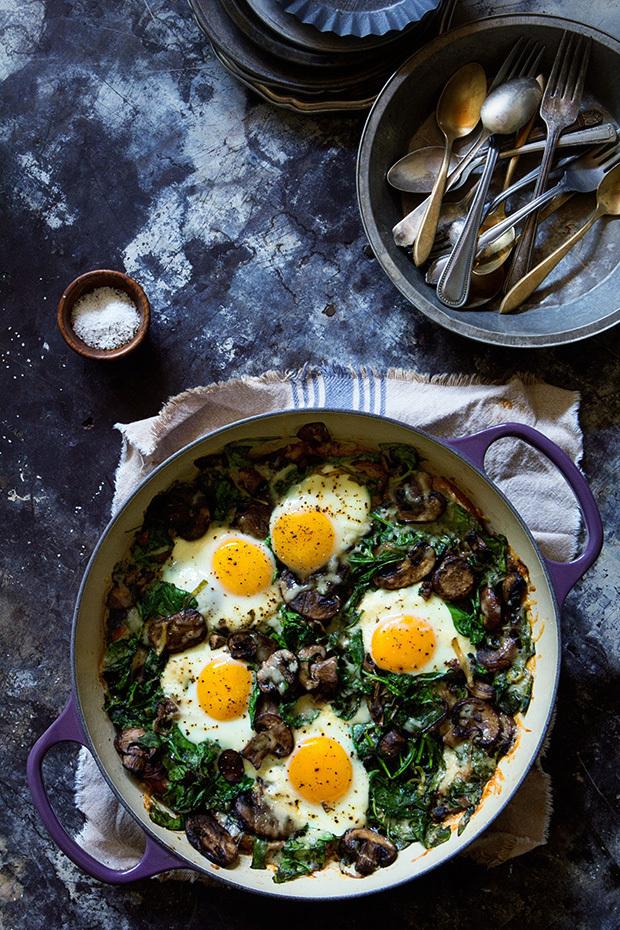
Spinach with egg
Spinach (after heat treatment) is charged passerovannym in butter onions, black or white pepper, salt, pour the beaten eggs with the chopped parsley, turmeric and baked in the oven.
Spinach with egg and cheese
Spinach (after heat treatment) is ground, mixed with grated cheese, salt, pepper, add raw eggs, whipped with a whisk and bake in small pancakes.
Salad parsnip
The roots are washed, cleaned from the skin, rubbed on a grater (large or small), mixed with finely chopped green onions or leeks, add sour cream or mayonnaise.
Soup of parsnip

Heat in a skillet mixture of vegetable and butter and, stirring, fry it for 5-7 minutes, finely chopped onion, parsnips and crushed garlic cloves. Add the flour, stir and fry another minute. Heat up vegetable or meat broth, pour the contents of the pan, bring to the boil, reduce the fire and cook 20 minutes, then remove the pan from the heat. Take out with a slotted spoon on a plate a few large pieces of vegetables, the remaining shift in the blender and pulverized for one minute. In the absence of a blender you can wipe the vegetables through a sieve with a wooden spoon. Again everything is put in a pot, add a halved lemon slices, salt, pepper and heat 5 minutes.
Products: 3 of root Pasternak, 1 onion, 2 cloves of garlic, 850 ml vegetable or beef broth, 1 tbsp vegetable oil, 1 tbsp butter, 1 tbsp wheat flour, 2 Cup of lemon, salt, black pepper.
The side dish of parsnip
Roots incubated for one hour in cold water with lemon juice, remove, cut, pour cold water so that it covers the vegetables, put salt, flour, butter and stew for one hour. Served with boiled beef and other meat dishes.
Products: 600 g root vegetables, 1 tbsp flour, 1 tbsp butter, lemon juice, salt.
Creamy cheesy casserole Pasternak
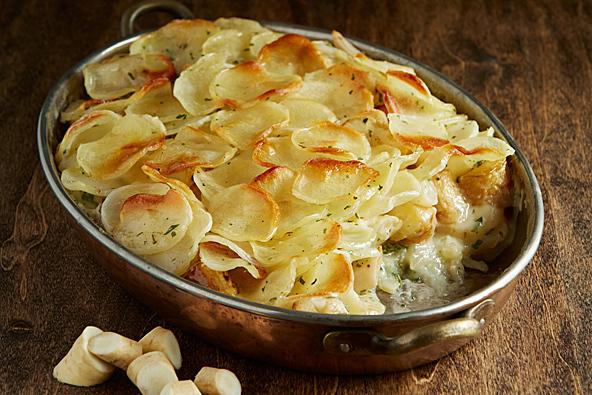
Form for baking grease with butter and lay a cleaned and cut into thin slices parsnips. In cream add half grated cheese, crushed garlic cloves, pepper, turmeric, mixed and the obtained mixture is poured parsnips. Cover with foil, place in a preheated 190оС the oven and bake for 1 hour 10 minutes. The remaining half of the grated cheese mixed with bread crumbs, remove the foil, sprinkle the casserole and again put in the oven for 5-10 minutes until the top appears crispy crust.
Products: 15 g butter, 1 kg medium-sized root-parsnip, 0.5 liters of cream, 50 g grated cheese (preferably Parmesan), 2 cloves of garlic 4 tbsp fresh bread crumbs, salt, turmeric, pepper. published
P. S. And remember, only by changing their consumption — together we change the world! ©
Join us in Facebook , Vkontakte, Odnoklassniki
Source: www.goodsmatrix.ru/internet-articles/226.html
If there is in the world the plant, which was not lucky with the reputation, so is spinach. In the twenties and thirties of the last century appeared in print scientific articles in which it was reported that this fruit contains an incredible amount of chlorophyll and a lot of iron oxides, even called number — 3%.
Spinach was first announced a panacea, zeleste izanai anemia, and then adding the biological activity of chlorophyll, began to argue that he has a fantastic ability to increase hemoglobin in the blood. Echoes of this confusion can be found even now. In some articles still argues that the quantity and vitamin content of spinach is much superior to other green and spicy culture and that of protein is as much as in milk, and a lot of iron oxides and of course spinach can be "cured" of many illnesses.

In fact, 3% of iron oxides found in the ash of the aerial parts of the plant, and this figure is overpriced, and the chlorophyll in the leaves a little more than in green leaves of any vegetable plants. Iron spinach contains about the same amount as potatoes, vitamins and other nutrients are present in virtually the same quantities as in other green crops. Spinach is undoubtedly useful, but it does not need to be credited with "miraculous" properties. It's a good green vegetable, but other only among equals.
It is believed that vegetable spinach (Spinacea oleracea L.) was cultivated long before BC in the middle East from widespread in those parts of the weed, a relative of well-known quinoa. In the VIII century, the spinach came to Spain with the Arab conquerors (the Arabs conferred on him the title "king of vegetables"), and then starting from the XV century thanks to the unpretentiousness to growing conditions, rapid growth and ease of cooking has spread to other European countries; it is especially partial to the Italians and French. But most of all were lucky the spinach in the USA, where he was with the first settlers and is still grown in huge quantities.
In Russia, the spinach as a vegetable crop began to be planted from the middle of XVIII century, but common, and even more a favorite vegetable, it did not become. Low popularity it owes its not very high taste, but the drawback is easy to fix, is to learn how to cook him meals.
Besides the usual for each plant proteins, fats, mono - and disaccharides, starch, fiber, organic acids spinach leaves contain flavonoids and a very good, balanced by nature multivitamin complex, which have provitamin a (carotenoids), b vitamins, C, P, PP, E, N. These vitamins in the spinach leaves accompanied by almost all necessary for the human macro - and microelements.
The variety of vitamins in combination with at least various minerals makes spinach a useful green vegetable for people of any age. It is used as a dietary product for diseases of the nervous system, exhaustion, anemia, anemia, hypertension, diabetes, gastritis, enterocolitis, he has a mild tonic, laxative, diuretic and anti-inflammatory action. Useful for recovering after a serious illness. And not only recommended for those who suffer from urinary, kidney, gallstone disease and gout.
One way or another, but to ignore this useful vegetable culture, all the more that to grow spinach is a snap.
How to grow spinach
To have a harvest throughout the summer and fall, you should sow the spinach seeds in open ground since the first of may. But since they do not germinate, they must first be soaked in a box with sawdust, place in open plastic bag and place in a warm place. After a week naklyunulis seeds can be sown at a depth of 2-3 cm and not a lot, otherwise the crop will be small. Between the grooves it is recommended to leave 25-30 cm In the phase of two true leaves the plants need to thin out, leaving between them at least 10 cm higher the yield will increase if you add pure humus and ash or lime, if the soil is acidic. Like spinach nitrophoska fertilizer and frequent watering, because the lack of moisture in the soil the seedlings appear late and disjointed, the leaves will be small, hard and plant quickly goes to flowering.
Crop harvested in 20-40 days after sowing, when plants have already formed a rosette of five or six leaves, and some will even see a small stem. Clean the spinach all at once, and since the leaves had a delicate and fade quickly, it's better to do early in the morning. The plant should pull out of the ground by the roots, shake, remove the yellow and damaged leaves and put roots down in a row. Fresh spinach leaves can be stored for five to seven days at a temperature of 1 ° C and relative humidity of 95%. They can and freeze. At a temperature of minus 1-2°C, the spinach stored for three months.
To obtain extra-early harvest next year's spinach seeds should be sown about the middle of August and well cover for the winter, not forgetting, if necessary, watered. By the end of the season, the plants formed small rosettes of leaves that are not taking cover, and leave for the winter. In early spring, immediately after snow melt, the spinach will "Wake up" and begin to grow rapidly. Literally 10-15 days after the snow it is already possible to gather the first harvest.
How to choose the right spinach at the store
Those of you who are infinitely far from the thought to grow anything, you can buy spinach fresh or frozen. When buying pay attention to the condition of the leaves. They should be bright green and look as if they just plucked from the garden. Fresh leaves are better to consume immediately or the next day, otherwise they will lose flavor and color. On sale all year round comes frozen spinach; when properly cooked it does not lose its taste and useful properties.
Spinach is used both in fresh and in processed form. It is added to salads, prepared from pasta, mashed potatoes, and various dishes as well as juice, which is used for coloring dishes.
Before cooking spinach thoroughly washed the leaves, a little dried and placed in a bowl with a small amount of water, lightly salt and put on low heat. Close lid and stew in their own juice for 5-7 minutes, watching so that the mixture doesn't stick to the bottom. The liquid is then drained, squeeze spoon her remains. Now the spinach is ready to use it in most recipes.
When cooking spinach it turned out dish, the taste and appearance of which suggest sad thoughts, do not rush to send it in the trash. Try to apply a universal tool, capable of making any dish of spinach simply delicious: add lemon seasoning consisting of 1 tablespoon of olive oil and 1 teaspoon squeezed lemon juice.
WHITE ROOT
Another once popular, now almost forgotten root vegetable with so unhappy destiny that when you say his name, some people think that we are talking about the names of the famous poet. But the fact that the roots of parsnip have been appreciated by Russian gourmets in the early twentieth century, very few people know. Spacerace in pre-revolutionary Russia was preparing easy vegetable dishes that were in the most exquisite menus for ceremonial feasts and receptions. In Europe during the Renaissance, this plant was as popular as it is today conventional potatoes. Now the growers on their acres parsnips, can be counted on the fingers that is regrettable, because it is a spicy vegetable plant is very tasty and healthy.
How to grow parsnips
Parsnip (Pastinaca sativa L.) is a biennial vegetable plant with a fleshy, sweet, fusiform yellow-brown root (root). Culture cold-resistant, drought-resistant, photophilous, grows well in humus-rich, neutral soils. Parsnip seeds are sown in early spring in well-lit beds, are buried to a depth of 1.5-2 cm, leaving an aisle in the 20-30 cm Seeds germinate in 3-4 weeks. To speed up germination you can, if you pre-soak the seeds in water or nutrient solution. Emerged seedlings were thinned, leaving 10-15 cm between plants
The first two months of parsnip grows slowly, this time more weeding and loosening the soil. Plants watered rare, but abundant. It is important to remember that on hot days the leaves of parsnip secrete the essential oil, which, once on naked body, can cause skin burns. That is why the care of crops is best done early in the morning and after sunset, when the heat subsides, or on cloudy days.
The roots are dug in late autumn, but before the frost. In the refrigerator they can stay for up to four weeks, remaining quite fresh. To keep them until the next harvest is best in the wet sand at low temperature.
Health benefits of parsnip
Parsnip contains fat, starch, mono - and disaccharides, dietary fiber, organic acids. Discovered a natural complex of vitamins, macro - and micronutrients are similar in composition to the complex of vitamins in spinach leaves, but somewhat fewer in number. Root vegetables are relatively high in carbohydrates and proteins, making them more nutritious than spinach.
Parsnips can be used as a dietary product, appetite stimulating and provide beneficial effects on digestion and assimilation of food. Has a slight diuretic effect, so it should be included in the diet diet in disease ies, accompanied by fluid retention in the body.The essential oil contained in the roots, enhances libido.
The roots of a peculiar odor and a sweetish spicy taste.
Use parsnips for cooking stews, add it to soups, use as a garnish to the meat. Widely used in canning vegetables, pickling cucumbers, add to marinades.
Candidate of pharmaceutical Sciences I. Sokolskiy
RECIPES SPINACH AND PARSNIP
Spring spinach salad
Fresh leaves are cut into strips, mix with chopped green onions, sprinkled with lemon juice and vegetable oil, slightly salted and add a bit of sugar.
Spinach salad
Fresh spinach leaves cut into strips, cucumbers and tomatoes — thin slices, hard-boiled eggs — diced. All mixed, add shinkovanny green onions, lemon juice, cracked pepper, and seasoned mayonnaise with sour cream.
Spinach soup
Finely chopped fresh spinach boil 5 minutes in water. Are sauteed in butter to flour, diluted with milk, add to broth with spinach. Salt, pepper, and 5-10 minutes to put on the stove. Serve with croutons.
If you are using frozen spinach add it, still frozen, directly into the boiling water, bring to a boil and cook 5 minutes.
Products: 500 g spinach, 60 g butter, 2 St. spoon flour, 0.5 l milk, 0,5 l water, black pepper, salt.

Spinach with egg
Spinach (after heat treatment) is charged passerovannym in butter onions, black or white pepper, salt, pour the beaten eggs with the chopped parsley, turmeric and baked in the oven.
Spinach with egg and cheese
Spinach (after heat treatment) is ground, mixed with grated cheese, salt, pepper, add raw eggs, whipped with a whisk and bake in small pancakes.
Salad parsnip
The roots are washed, cleaned from the skin, rubbed on a grater (large or small), mixed with finely chopped green onions or leeks, add sour cream or mayonnaise.
Soup of parsnip

Heat in a skillet mixture of vegetable and butter and, stirring, fry it for 5-7 minutes, finely chopped onion, parsnips and crushed garlic cloves. Add the flour, stir and fry another minute. Heat up vegetable or meat broth, pour the contents of the pan, bring to the boil, reduce the fire and cook 20 minutes, then remove the pan from the heat. Take out with a slotted spoon on a plate a few large pieces of vegetables, the remaining shift in the blender and pulverized for one minute. In the absence of a blender you can wipe the vegetables through a sieve with a wooden spoon. Again everything is put in a pot, add a halved lemon slices, salt, pepper and heat 5 minutes.
Products: 3 of root Pasternak, 1 onion, 2 cloves of garlic, 850 ml vegetable or beef broth, 1 tbsp vegetable oil, 1 tbsp butter, 1 tbsp wheat flour, 2 Cup of lemon, salt, black pepper.
The side dish of parsnip
Roots incubated for one hour in cold water with lemon juice, remove, cut, pour cold water so that it covers the vegetables, put salt, flour, butter and stew for one hour. Served with boiled beef and other meat dishes.
Products: 600 g root vegetables, 1 tbsp flour, 1 tbsp butter, lemon juice, salt.
Creamy cheesy casserole Pasternak

Form for baking grease with butter and lay a cleaned and cut into thin slices parsnips. In cream add half grated cheese, crushed garlic cloves, pepper, turmeric, mixed and the obtained mixture is poured parsnips. Cover with foil, place in a preheated 190оС the oven and bake for 1 hour 10 minutes. The remaining half of the grated cheese mixed with bread crumbs, remove the foil, sprinkle the casserole and again put in the oven for 5-10 minutes until the top appears crispy crust.
Products: 15 g butter, 1 kg medium-sized root-parsnip, 0.5 liters of cream, 50 g grated cheese (preferably Parmesan), 2 cloves of garlic 4 tbsp fresh bread crumbs, salt, turmeric, pepper. published
P. S. And remember, only by changing their consumption — together we change the world! ©
Join us in Facebook , Vkontakte, Odnoklassniki
Source: www.goodsmatrix.ru/internet-articles/226.html
The law of donations or How to become happier
10 best ways to ask the right questions to solve problems
